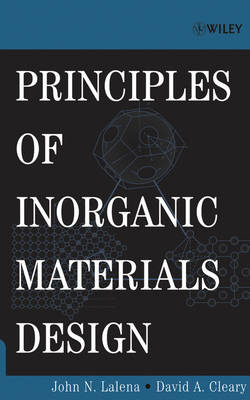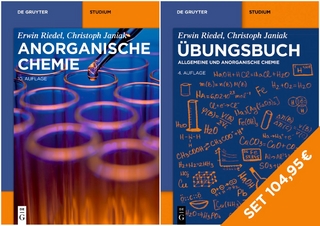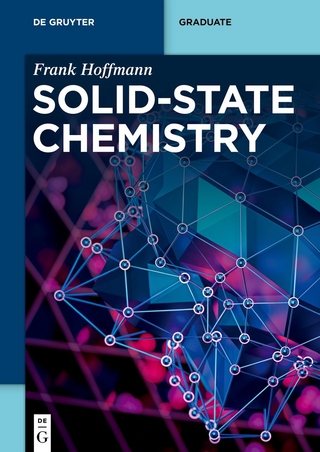
Principles of Inorganic Materials Design
John Wiley & Sons Inc (Verlag)
978-0-471-43418-4 (ISBN)
- Titel ist leider vergriffen;
keine Neuauflage - Artikel merken
A unique interdisciplinary approach to inorganic materials design Textbooks intended for the training of chemists in the inorganic materials field often omit many relevant topics. With its interdisciplinary approach, this book fills that gap by presenting concepts from chemistry, physics, materials science, metallurgy, and ceramics in a unified treatment targeted towards the chemistry audience. Semiconductors, metal alloys and intermetallics, as well as ceramic substances are covered. Accordingly, the book should also be useful to students and working professionals in a variety of other disciplines. This book discusses a number of topics that are pertinent to the design of new inorganic materials but are typically not covered in standard solid-state chemistry books. The authors start with an introduction to structure at the mesoscopic level and progress to smaller-length scales. Next, detailed consideration is given to both phenomenological and atomistic-level descriptions of transport properties, the metal-nonmetal transition, magnetic and dielectric properties, optical properties, and mechanical properties.
Finally, the authors present introductions to phase equilibria, synthesis, and nanomaterials. Other features include: Worked examples demonstrating concepts unfamiliar to the chemist Extensive references to related literature, leading readers to more in-depth coverage of particular topics Biographies introducing the reader to great contributors to the field of inorganic materials science in the twentieth century With their interdisciplinary approach, the authors have set the groundwork for communication and understanding among professionals in varied disciplines who are involved with inorganic materials engineering. Armed with this publication, students and researchers in inorganic and physical chemistry, physics, materials science, and engineering will be better equipped to face today's complex design challenges. This textbook is appropriate for senior-level undergraduate and graduate course work.
JOHN N. LALENA, PhD, is a private consultant. He was formerly a senior research scientist for Honeywell Electronic Materials, and a semiconductor fabrication process/product engineer for Texas Instruments. He also has served as a visiting professor of chemistry at Gonzaga University. DAVID A. CLEARY, PhD, is Professor of Chemistry and Chair of the Department of Chemistry at Gonzaga University. His courses have included physical chemistry and solid-state chemistry. His research interests range from nonlinear optical materials to chemical sensors and ionic conductors.
Foreword.Preface.1. The Mesoscale.1.1 Interfaces in Polycrystals.1.2 Solidified Metals and Alloys.1.3 Ceramic Powder Aggregates.1.4 Thin-Film Microstructure.2. Crystal Structure and Bonding.2.1 Structure Description Methods.2.2 Cohesive Forces in Solids.2.3 Structural Energetics.2.4 Common Structure Types.2.5 Structural Disturbances.2.6 Structural Control and Synthetic Strategies.3. The Electronic Level, I: An Overview of Band Theory.3.1 The Many-Body Schro dinger Equation.3.2 Bloch's Theorem.3.3 Reciprocal Space.3.4 A Choice of Basis Sets.3.5 Understanding Band-Structure Diagrams.3.6 Breakdown of the Independent Electron Approximation.3.7 Density Functional Theory: An Alternative to the Hartree-Fock Approach.4. The Electronic Structure, II: The Tight-Binding Approximation.4.1 The General LCAO Method.4.2 Extension of the LCAO Method to Crystalline Solids.4.3 Orbital Interactions in Monatomic Solids.4.4 Tight-Binding Assumptions.4.5 Qualitative LCAO Band Structures.4.6 Total Energy Tight-Binding Calculations.5. Transport Properties.5.1 An Introduction to Tensors.5.2 Thermal Conductivity.5.3 Electronic Conductivity.5.4 Atomic Transport.6. Metal-Nonmetal Transitions.6.1 Correlated Systems.6.2 Anderson Localization.6.3 Experimentally Distinguishing Electron Correlation from Disorder.6.4 Tuning the Metal-Nonmetal Transition.6.5 Other Types of Electronic Transitions.7. Magnetic and Dielectric Properties.7.1 Macroscopic Magnetic Behavior.7.2 Atomic Origin of Paramagnetism.7.3 Spontaneous Magnetic Ordering.7.4 Magnetotransport Properties.7.5 Magnetostriction.7.6 Dielectric Properties.8. Optical Properties of Materials.8.1 Maxwell's Equations.8.2 Refractive Index.8.3 Absorption.8.4 Nonlinear Effects.8.5 Summary.9. Mechanical Properties.9.1 Basic Definitions.9.2 Elasticity.9.3 Plasticity.9.4 Fracture.10. Phase Equilibria, Phase Diagrams, and Phase Modeling.10.1 Thermodynamic Systems, Phases, and Components.10.2 The First and Second Laws of Thermodynamics.10.3 Understanding Phase Diagrams.10.4 Experimental Phase-Diagram Determinations.10.5 Phase-Diagram Modeling.11. An Introduction to Nanomaterials.11.1 History of Nanotechnology.11.2 Properties of Matter at the Nanoscale.12. Synthetic Strategies.12.1 Synthetic Strategies.12.2 Summary.Index.
| Erscheint lt. Verlag | 17.5.2005 |
|---|---|
| Zusatzinfo | Illustrations, ports. |
| Verlagsort | New York |
| Sprache | englisch |
| Maße | 161 x 241 mm |
| Gewicht | 710 g |
| Einbandart | gebunden |
| Themenwelt | Naturwissenschaften ► Chemie ► Anorganische Chemie |
| Technik ► Maschinenbau | |
| ISBN-10 | 0-471-43418-3 / 0471434183 |
| ISBN-13 | 978-0-471-43418-4 / 9780471434184 |
| Zustand | Neuware |
| Haben Sie eine Frage zum Produkt? |
aus dem Bereich


